- home
- BAKERECIPES
BakeRecipes
Bringing real baking into your home with deliciously simple recipes.
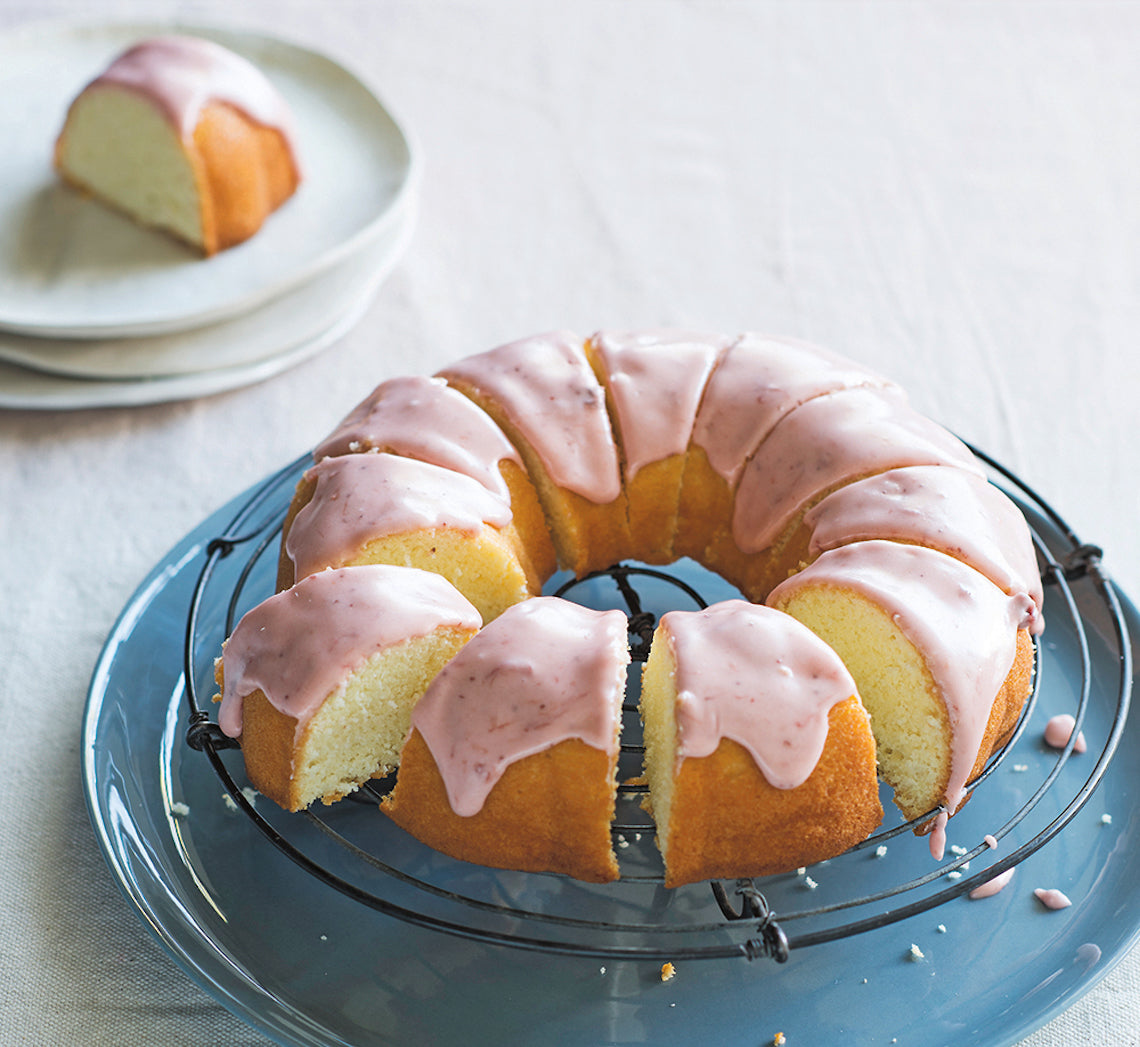
Prep 20min (+ 1hr cooling and 40min standing time)Bake 30minMakes 10 serves
This cake really seems to have its method all mixed up but I promise you it works – and works beautifully, at that!
Ingredients
Melted butter, extra, to grease
220g (1 cup) caster (superfine) sugar
150g (1 cup) plain (all-purpose) flour
1½ tablespoons cornflour (cornstarch)
1 teaspoon baking powder
6 egg whites, at room temperature
100g unsalted butter, melted and cooled
Strawberry icing
125g (1 cup) pure icing (confectioners') sugar
1½ tablespoons smooth strawberry jam
2–2¼ teaspoons water
Method
- Preheat the oven to 180°C (160°C fan-forced). Brush a 2.5 litre (10 cup) capacity fluted ring (bundt) tin with melted butter to grease.
- Sift together the sugar, flour, cornflour and baking powder.
- Use an electric mixer with a whisk attachment to whisk the egg whites on medium or medium–high speed in a clean dry bowl until soft peaks just form.
- Sift the dry ingredients again over the egg whites and use a large metal spoon or spatula to fold until just combined. Pour over the melted butter and fold in until just combined.
- Pour the mixture into the greased tin and smooth the surface with the back of a spoon. Bake in the preheated oven for 30 minutes, or until a skewer inserted in the cake comes out clean. Leave the cake to stand in the tin for 10 minutes before turning out onto a wire rack to cool for about 1 hour.
- To make the Strawberry icing, sift the icing sugar into a medium bowl. Combine the jam and 2 teaspoons of the water, add to the icing sugar and stir until smooth and a thick coating consistency, adding the remaining ¼ teaspoon water if needed.
- Spoon the icing over the cooled cake, allowing it to dribble down the sides. Set aside for about 30 minutes, or until the icing is set. Serve in slices.
Baker's Tips
- This cake will keep in an airtight container at room temperature for up to 3 days.
- You can replace the strawberry jam with another jam of your choice – blackberry, raspberry and plum all work well.
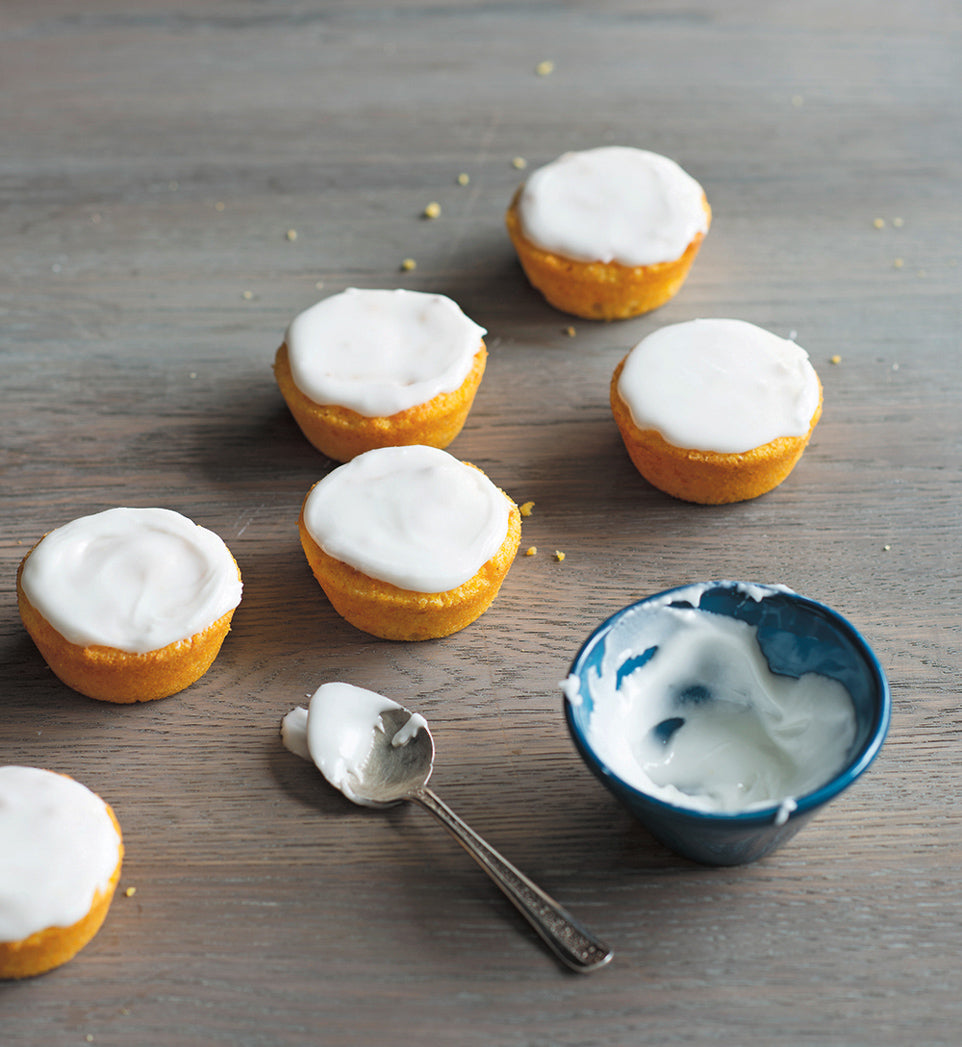
Prep 20min (+ 30-60min simmering, cooling and 20min standing time)Bake 15-18minMakes 12
These cakes are a play on the original (and wonderful) Middle Eastern Orange Cake from the one and only Elizabeth David. Making use of seasonal mandarins and with the addition of coconut and polenta, this version is also flourless and gluten-free.
Ingredients
2 large mandarins (about 110g)
Melted butter, to grease
100g (1 cup) almond meal
95g (½ cup) instant polenta
45g (½ cup) desiccated coconut
½ teaspoon gluten-free baking powder
3 eggs, at room temperature
165g (¾ cup) caster (superfine) sugar
1½ teaspoons natural vanilla extract or essence
250g (2 cups) pure icing (confectioners') sugar
1½–2 tablespoons mandarin juice
Method
- Put the whole mandarins in a small saucepan, cover with water and set over high heat. Bring to the boil, reduce the heat and simmer for 30–60 minutes, or until very soft when tested with a skewer. (You may need to place a small saucer over the mandarins to keep them submerged.) Remove the mandarins from the water and set aside to cool slightly.
- Meanwhile, preheat the oven to 180°C (160°C fan-forced). Brush a 12-hole 80ml (⅓ cup) capacity silicone or metal muffin tin with melted butter to grease. Quarter the mandarins and remove and discard the centre core and any seeds. Purée the skin and flesh in a small food processor or blender until smooth.
- Put the almond meal, polenta, coconut and baking powder in a medium bowl and mix well to combine.
- Put the eggs, sugar and vanilla in a medium bowl and use an electric mixer with a whisk attachment to whisk on high speed until very thick and pale and a ribbon trail forms when the whisk is lifted (about 3–4 minutes).
- Add the mandarin purée to the egg mixture and use a spatula or large metal spoon to fold in until just combined. Add the polenta mixture and fold together until combined. Divide the mixture evenly among the muffin holes (you can pour it from a jug or use a ladle).
- Bake in the preheated oven for 15–18 minutes, or until a skewer inserted in the cakes comes out clean. Cool the cakes in the tin for 5 minutes. Use a palette knife to ease the cakes out and transfer to a wire rack to cool.
- To make the Mandarin icing, sift the icing sugar into a medium bowl. Gradually stir in the juice until the mixture is smooth and has a thick coating consistency, adding a little more juice if too thick. Cover with plastic wrap and set aside at room temperature until ready to use.
- Spread the tops of the cooled cakes with the icing. Set aside for 20 minutes or until set.
Baker's Tips
- These cakes will keep in an airtight container in a cool place (but not in the fridge) for up to 2 days.

Prep 1hr (+30min cooling and 30min standing time)Bake 20minMakes 12
Hailing from the deep south of North America, Lady Baltimore cake is a classic wedding cake choice. With its simple buttercake layers, fruit and nut filling and dreamy meringue frosting, the resulting flavour combination is delightfully complex. These individual cakes are made just for one.
Ingredients
Melted butter, to grease185g butter, softened
145g (⅔ cup) caster sugar, plus 75g (⅓ cup) extra
1 teaspoon natural vanilla essence or extract
1 orange, zest finely grated
225g (1½ cups) plain flour
2 teaspoons baking powder
165ml (⅔ cup) milk
3 egg whites
Filling
45g (¼ cup) raisins, chopped45g (¼ cup) chopped dried figs
2 tablespoons brandy
40g (⅓ cup) chopped toasted walnuts
Meringue Frosting
- 3 egg whites
- 150g (⅔ cup) caster sugar
- 1 teaspoons natural vanilla essence or extract
Method
- Preheat the oven to 180°C (160°C fan-forced). Brush a 12-hole 125ml (½ cup) friand pan with melted butter to grease.
- To make the filling, combine the raisins, figs and brandy in a small saucepan and heat over low heat for 3-5 minutes or until heated through. Remove from the heat and set aside to cool.
- Use an electric mixer to beat the butter, 145g (⅔ cup) caster sugar, vanilla and orange zest, scraping down the sides of the bowl when necessary, until pale and creamy.
- Sift together the flour and baking powder. With the motor running on the lowest possible speed, beat in the flour alternately with the milk, in 2 separate batches each, until just combined.
- In a separate clean dry medium mixing bowl, use a whisk attachment to whisk the egg whites until soft peaks form. Gradually add the extra caster sugar, a spoonful at a time, and whisk on medium-high speed until thick and glossy. Use a large metal spoon or spatula to fold a large spoonful of the egg white mixture through the butter mixture until well combined. Add the remaining egg white mixture and fold until just combined. Divide the mixture evenly among the friand holes and smooth the surfaces. Bake for 20 minutes or until a skewer inserted in the the centre of the cakes comes out clean. Stand the cakes in the tin for 5 minutes before turning out onto a wire rack to cool completely.
- Meanwhile, make the meringue frosting. Choose a medium heatproof mixing bowl that sits snugly on top of a medium saucepan. Quarter-fill the saucepan with water and bring to the boil. Reduce the heat to the lowest possible setting. Put the eggwhites and sugar in the heatproof bowl and place over the simmering water. Use a spatula to stir until the sugar dissolves. (You can tell if the mixture is ready by rubbing a little between your fingers – if it still feels grainy, then continue to stir for another minute or until it no longer feels grainy.) Transfer the mixture to the bowl of an electric mixer and use a whisk attachment to whisk on high speed for 5-8 minutes or until the meringue has cooled to room temperature and is very thick and glossy. Whisk in the vanilla. Transfer two-thirds of the frosting to a bowl, cover with plastic wrap and set aside.
- To finish the filling, transfer the remaining third of the frosting to a medium bowl and fold in the chopped walnuts and the fruit mixture.
- Use a small sharp serrated knife to cut the cakes in half horizontally and trim the tops to level, if necessary. Spread a little of the filling over the bottom halves of the cakes and sandwich with the top halves, pressing down.
- Spread the reserved meringue frosting over the sides and tops of the cakes to cover, swirling as desired. Set aside for 30 minutes for the frosting to firm slightly before serving.
Baker's Tips
- These cakes will keep in an airtight container at room temperature for up to 2 days.
Photography by Alan Benson.
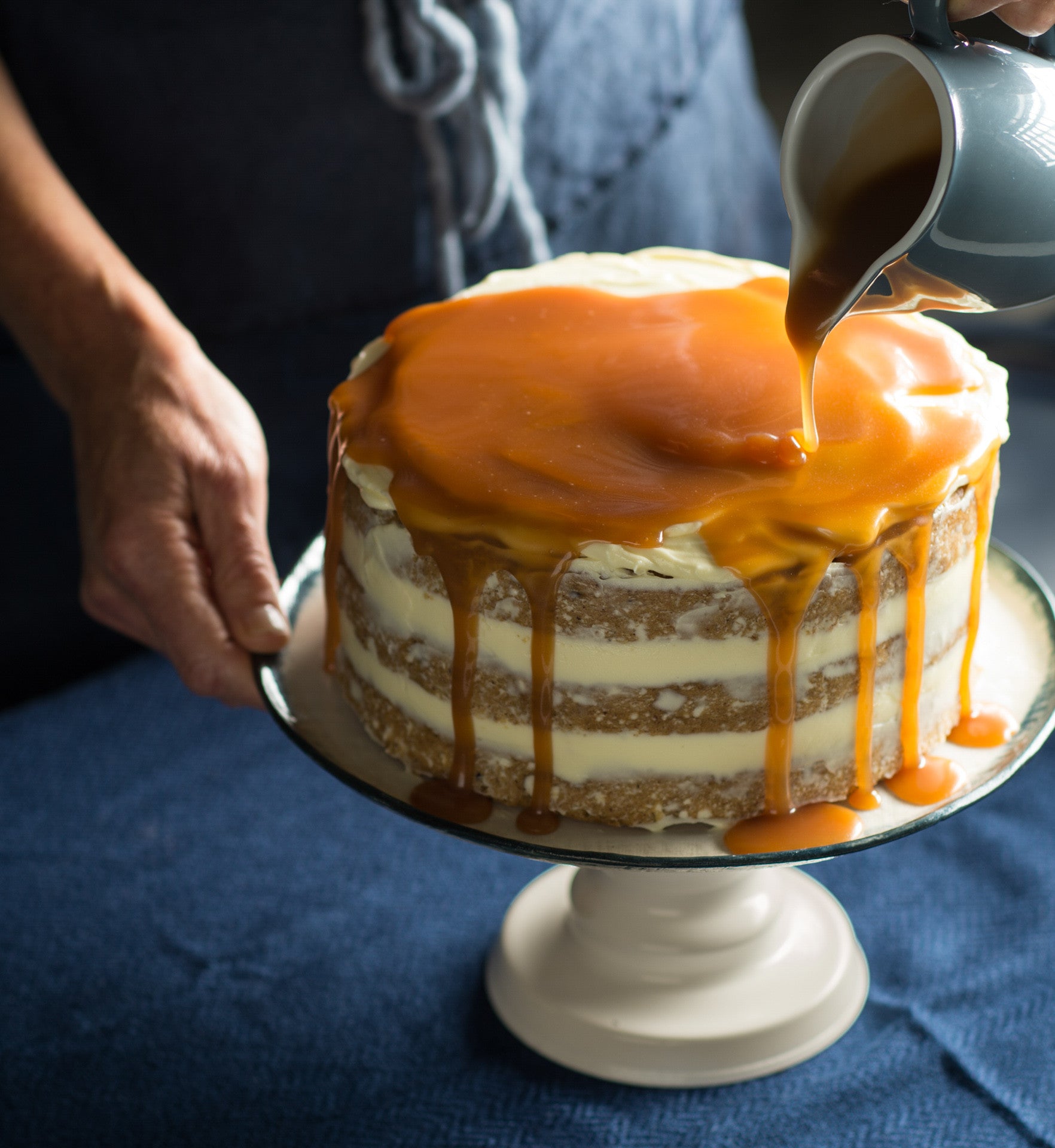
Prep 35min (+1hr cooling time)Bake 25minMakes 12 serves
Layer upon layer, this impressive cake is deceptively simple to make. What’s more, you could call it a hazelnut hummingbird cake with the added bonus of lashings of caramel. Now what’s not to love about that!
Ingredients
Banana and hazelnut cake layers
Melted butter, to grease
300g (2 cups/10½oz) plain flour
3½ teaspoons baking powder
2 teaspoons ground cinnamon
½ teaspoon ground cardamom
220g (1 cup, firmly packed/7¾oz) brown sugar
100g (3½oz) hazelnut meal
60g (⅔ cup/2oz) desiccated coconut
150g (5¼oz) salted butter, melted and cooled
3 eggs, at room temperature, lightly whisked
4 ripe medium bananas (about 200g/7oz each), mashed
2 teaspoons natural vanilla extract or essence
Caramel
165g (¾ cup/5¾oz) caster sugar
60ml (¼ cup/2fl oz) water
150ml (5fl oz) pouring cream
30g (1oz) salted butter, cubed
Cream cheese frosting
250g (9oz) cream cheese, cubed, at room temperature
80g (2¾oz) salted butter, cubed, at room temperature
1 teaspoon natural vanilla essence or extract
185g (1½ cups/6½oz) icing sugar
Method
- To make the cake layers, preheat the oven to 180°C/350°F (160°C/315°F fan-forced). Brush three shallow 20cm/8in round cake tins with the melted butter to grease and line the bases with non-stick baking paper.
- Sift together the flour, baking powder, cinnamon and cardamom into a large bowl. Stir in the brown sugar, hazelnut meal and coconut and stir with a wooden spoon to combine, breaking up any lumps. Make a well in the centre. Use a fork to whisk together the butter, eggs, banana and vanilla until well combined. Add to the dry ingredients and use a spatula or large metal spoon to fold together until just combined.
- Divide the cake mixture evenly among the prepared cake tins, smoothing the surface with the back of a spoon. Bake in preheated oven for 25 minutes, swapping the tins around halfway through baking, until pale golden and a skewer inserted into the centre of the cakes comes out clean. Stand the cakes in the tins for 5 minutes before transferring to wire racks to cool.
- Meanwhile, to make the Caramel, combine the caster sugar and water in a small saucepan and use a wooden spoon to stir over low heat until the sugar dissolves. Increase the heat to medium and bring to the boil. Boil without stirring for about 10 minutes, brushing down the side of the pan with a pastry brush dipped in water to dissolve any sugar crystals, until the mixture turns a deep caramel. Remove immediately from the heat and carefully add the cream and butter. Stir with a wooden spoon until well combined and the caramel is smooth. Return the saucepan to a medium heat if any lumps remain to dissolve them, stirring constantly. Brush a little of the hot caramel over the warm cakes.
- Pour the Caramel into a heatproof bowl or jug and set aside to cool, stirring occasionally this will take about 1 hour).
- Meanwhile to make the Cream Cheese Frosting, use an electric mixer to beat the cream cheese, butter and vanilla until well combined and creamy. With the mixer running, gradually beat in the icing sugar until well combined and smooth. Cover and set aside in a cool spot (but not in the fridge).
- To assemble the cake, spread about ½ cup of the cream cheese frosting over the top of one of the cake layers. Top with another cake layer, another ½ cup frosting and the remaining cake layer. Spread a thin layer of frosting around the outside of the cake so that the cake layers show through. Spread the remaining frosting on top. Pour a generous amount of the caramel over the top of the cake, allowing it to drizzle down the sides. Serve in wedges with the remaining caramel passed separately, if desired.
Baker's Tip
- This cake will keep in an airtight container in the fridge for up to 3 days. Stand at room temperature for 30 minutes before serving.
Photography by Alan Benson.
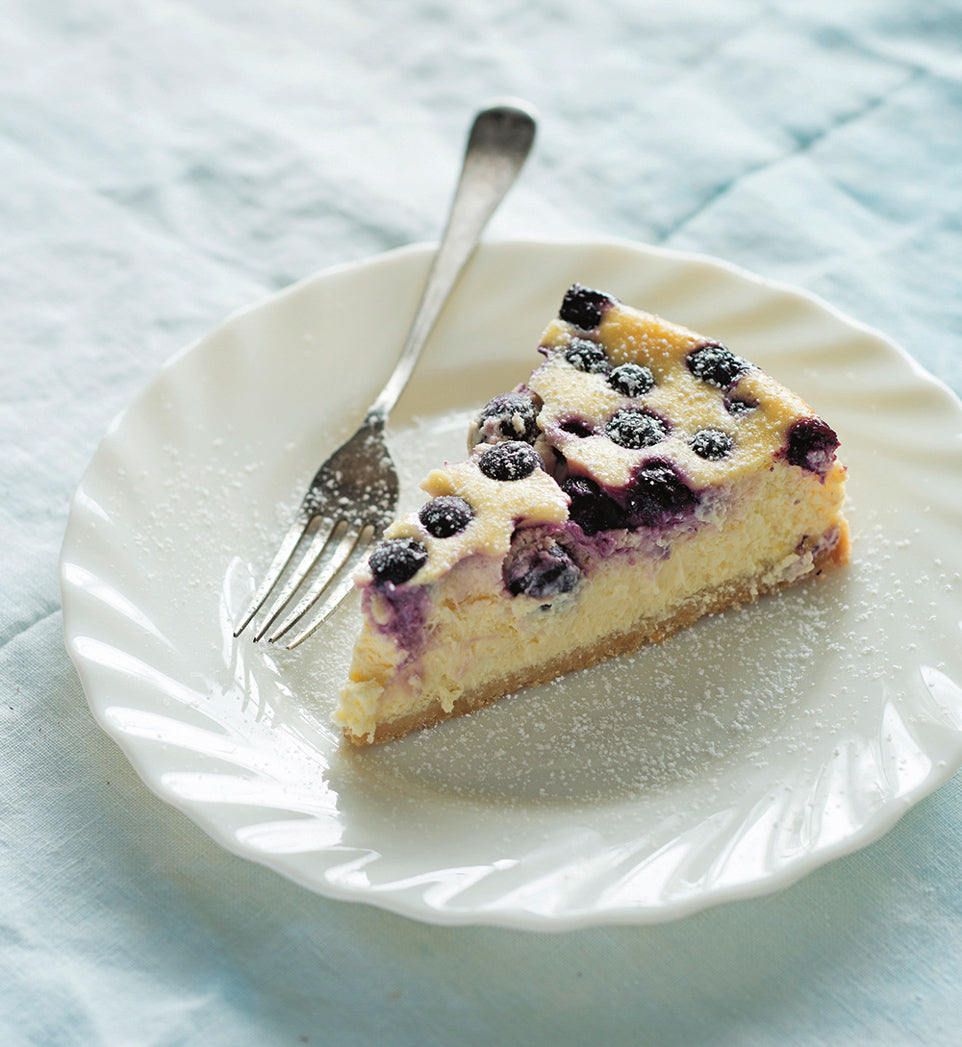
Prep 25min (+ 1hr cooling and 3hr chilling time)Bake 1hr 10minMakes 10 serves
Bringing together sweet blueberries and sour lemons, this simple cheesecake is light but luscious. It's the perfect end to a lazy summer meal.
Ingredients
Melted butter, extra, to grease
375g cream cheese, at room temperature, cubed (see Baker's Tips)
3 eggs, at room temperature
185g (¾ cup) sour cream
125ml (½ cup) thin (pouring) cream
165g (¾ cup) caster (superfine) sugar
1 tablespoon finely grated lemon zest
2 tablespoons freshly squeezed lemon juice
200g fresh or frozen blueberries (see Baker's tips)
Icing sugar, to dust
- 100g plain sweet biscuits
- 60g butter, melted
Method
- Preheat the oven to 150°C. Line the base of a 20cm (8 in) spring-form cake tin with baking paper. Brush the side of the tin with a little melted butter to grease.
- To make the Biscuit base, process the biscuits in a food processor until finely crushed. Add the butter and process until well combined. Sprinkle the mixture over the base of the tin and use the back of a metal spoon or the base of a glass to press down to cover evenly. Put the tin on a baking tray and place in the fridge.
- Clean the food processor bowl and process the cream cheese until smooth. Add the eggs and process until smooth. Add the sour cream, thin cream, sugar, lemon zest and juice and process until well combined and smooth, scraping down the side and base of the bowl when necessary. Pour into the tin over the base. Scatter the blueberries over the top.
- Bake for 1 hour 10 minutes or until the cheesecake is just set but the centre trembles slightly when the tin is shaken gently. Turn off the oven, use a wooden spoon to keep the oven door ajar and leave the cheesecake in the oven for 1 hour (this helps prevent the cheesecake from cracking). Transfer the cheesecake, still in the tin, to the fridge and chill for at least 3 hours or until well chilled. Dust with icing sugar and serve.
Variations
- Orange & Raspberry Cheesecake – Replace the lemon zest and juice with orange zest and juice. Replace the blueberries with fresh or frozen raspberries.
- Blueberry & White Chocolate Cheesecake – Replace the lemon zest and juice with 1½ teaspoons natural vanilla extract or essence. Melt 180g good-quality white chocolate and cool to room temperature. Add to the bowl of the food processor just before transferring the mixture to the tin and process until just combined.
- Individual Lemon & Blueberry Cheesecakes – Line a 12-hole 80ml (⅓ cup) capacity muffin tin with paper cases. Divide the biscuit base, cream cheese mixture and blueberries evenly among the cases. Bake at 160°C for 30 minutes. Cool as per the recipe, then chill in the fridge for at least 1 hour before removing the paper cases and serving.
Baker's Tips
- Having the cream cheese at room temperature means it will easily become smooth and creamy in the food processor. If you use it straight from the fridge it will take longer and you’ll need to scrape the side and base of the food processor frequently so that no lumps are left after processing.
- If using frozen blueberries, use them straight from the freezer – do not thaw.
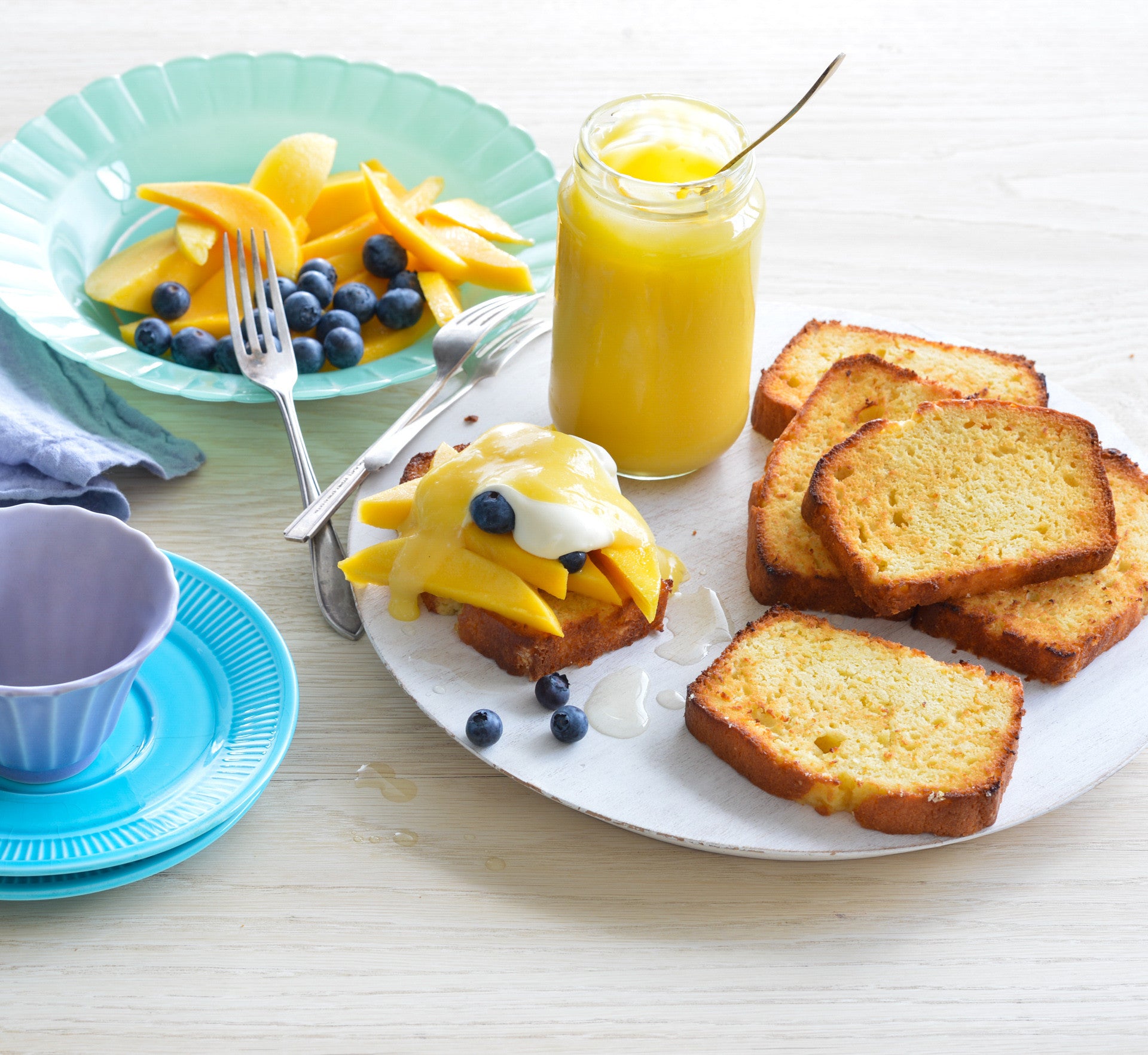
Prep 50min (+30min cooling time)
Bake 50minMakes 8-10 serves
A heavenly layering of mouth-puckering lemon pound cake, curd and syrup, teamed with summer fruits and ‘soured’ cream, this dessert is one for lemon-lovers. The cake is just as delicious served either plain, toasted or chargrilled – just take your pick!
Ingredients
- melted butter, to grease
- 125ml (½ cup) sour cream
- 125ml (½ cup) thickened cream
- 2 x 125g punnets blueberries, to serve
- 2 ripe medium mangoes, sliced, to serve
Lemon buttermilk pound cake
- 125g butter, at room temperature
- 220g (1 cup) caster sugar
- 2 eggs
- 1 tablespoon finely grated lemon zest
- 225g (1½ cups) plain flour
- ½ teaspoon bicarbonate of soda
- 125ml (½ cup) buttermilk
- 1 tablespoon strained fresh lemon juice
Lemon curd
- 125ml (½ cup) strained fresh lemon juice
- 165g (¾ cup) caster sugar
- 3 eggs, whisked and strained
- 100g unsalted butter, cubed, at room temperature
Lemon syrup
- 110g (½ cup) caster sugar
- 160ml (⅔ cup) strained fresh lemon juice
- 2 tablespoons water
Method
- To make the lemon buttermilk pound cake, preheat oven to 180°C (160°C fan-forced). Grease a 9cm x 19cm (base measurement) loaf tin and line the base and long sides with one piece of non-stick baking paper. Use an electric mixer to beat the butter and sugar until pale and creamy. Add the eggs one at a time, beating well after each. Beat in the lemon zest. Sift together the flour and bicarbonate of flour. Combine the buttermilk and lemon juice. On lowest possible speed beat in half the flour mixture and then half the buttermilk mixture until just combined. Repeat with the remaining flour and buttermilk mixtures in two more batches until just combined. Pour the mixture into the prepared tin and smooth the surface with the back of a spoon. Bake in preheated oven for 50 minutes or until a skewer inserted into the centre comes out clean. Leave to stand in the tin for 5 minutes before transferring to a wire rack to cool (this will take about 30 minutes).
- To make the lemon curd, combine the lemon juice, sugar and eggs in a medium heatproof bowl and place over a saucepan of simmering water (make sure the bowl doesn’t touch the water). Stir with a wooden spoon for 10-12 minutes or until the mixture thickens to a consistency similar to pouring cream (do not boil). Remove the bowl from the saucepan and gradually stir in the butter until the butter is evenly incorporated and the curd is smooth. Cover with plastic wrap (see Baker’s tips) and place in the fridge to chill.
- To make the lemon syrup, combine the sugar, water and lemon juice in a small saucepan and stir over medium heat until the sugar dissolves. Bring to the boil and boil for 3 minutes or until reduced slightly.
- To serve, combine the cream and sour cream in a medium bowl and use a balloon whisk to whisk until soft peaks form. Transfer to a serving bowl. Preheat a chargrill pan on high (see Baker’s tips). Cut the cake into 1.5 cm-thick slices and toast in a toaster until lightly golden and warmed through. Transfer to a plate and place in the centre of the table with the curd, syrup, fruit and cream for guests to assemble their own dessert.
Baker's Tips
- The Lemon buttermilk pound cake will keep in an airtight container at room temperature for up to 2 days.
- If making the curd ahead of time, you can transfer it straight into a clean airtight jar, cover with an airtight lid and place in the fridge. It will keep in an airtight jar or container in the fridge for up to 1 week.
- The lemon syrup will keep in an airtight jar or container in the fridge for up to 2 weeks.
- The cake can be also toasted in a sandwich press or in a toaster until golden.
- The combined whipped cream and sour cream can be replaced by scoops of good-quality vanilla ice-cream if desired.
Photography by Alan Benson.
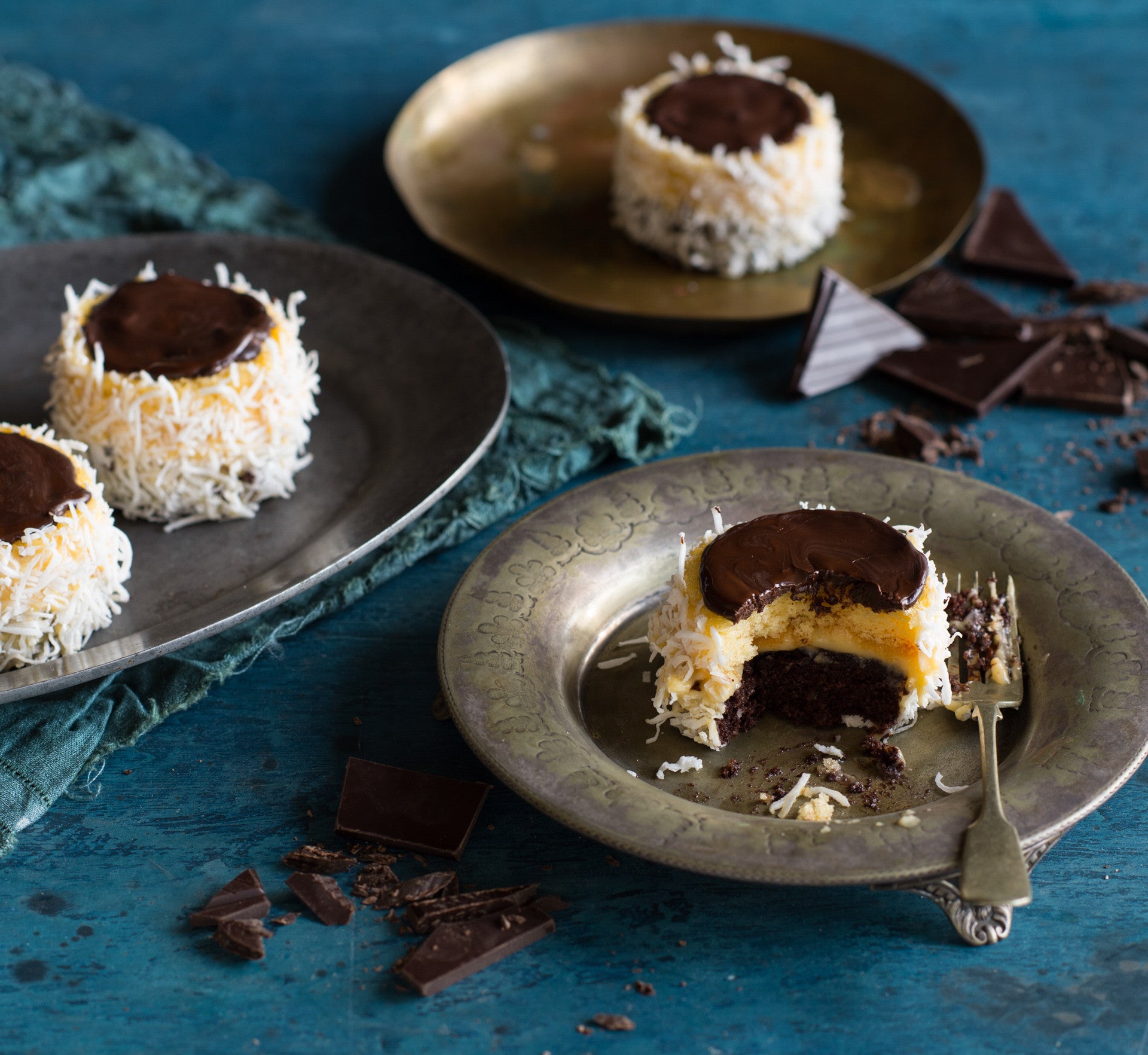
Prep 40min (+20min cooling and 2.5hr chilling)Bake 15minMakes 6 serves
These little layered cakes are the sweetest hats you'll find. Made up of custard cream and a chocolate topping they are covered in shredded coconut for a little texture but you can also use nuts as well, if you have them handy. They are best served chilled and if you aren't much for a dessert fork, then eating these with your hands like a cupcake is absolutely acceptable!
Ingredients
- 100g (1½ cups) shredded coconut, to coat
Sponge Layers
- melted butter, to grease
- 4 eggs, at room temperature
- 165g (¾ cup) caster sugar
- 2 tablespoons boiling water
- 2 tablespoons vegetable oil
- 100g (⅔ cup) self-raising flour, sifted
- 2 tablespoons cocoa powder mixed to a paste with 60 ml (¼ cup) boiling water and cooled
Custard cream
- 1 tablespoon cornflour
- 1 tablespoon custard powder
- 2 tablespoons caster sugar
- 200ml milk
- 20g butter, cubed
- 1 egg yolk
- 1½ teaspoons natural vanilla essence or extract
Chocolate glaze
- 50g dark chocolate, chopped
- 2 teaspoons vegetable oil
Method
- To make the custard cream, sift together the cornflour and custard powder into a small saucepan. Add the sugar and then use a balloon whisk to gradually stir in the milk. Place the saucepan over a medium heat and cook, stirring frequently, until the mixture boils and thickens. Remove from the heat and stir in the butter, egg yolk and vanilla until well combined. Pour into a medium bowl, cover the surface of the custard directly with a piece of plastic wrap and set aside to cool (this will take about 2 hours).
- To make the sponge layers, preheat oven to 180°C (160°C fan-forced). Brush two 16 x 26 cm shallow cake tins with a little melted butter to lightly grease and then line the base and two long sides of each with one piece of non-stick baking paper.
- Use an electric mixer with a whisk attachment on high speed to whisk the eggs and sugar in a large bowl until the mixture is very thick and pale (this will take 5-8 minutes). Lift the whisk out of the mixture and draw a figure eight, if the trail stays on the surface long enough for you to finish drawing then the mixture is ready. If not, continue to whisk for a further minutes and then test again.
- Combine the boiling water and oil. Sift the flour over the egg mixture. Immediately pour the warm water and oil mixture down the side of the bowl and use a spatula to fold until just evenly combined (be careful not to overmix).
- Pour half of the mixture into one of the prepared cake tins. Add the cocoa paste to the mixture still in the bowl and fold together until just combined. Pour into the second cake tin. Gently tap the tins on the bench top three times to settle the mixture. Bake in preheated oven for 12-15 minutes or until the cakes spring back when lightly touched in the centre and start pulling away from the sides of the tins. Stand the cakes in the tins for 2 minutes before turning onto a wire racks to cool completely.
- To assemble, use a 6 cm round cutter to cut each of the Sponge cakes into 6 rounds. Place the round cutter over a chocolate sponge. Top the chocolate sponge round with about 1 tbsp of the Custard cream and then cover with around of plain sponge. Remove the pastry cutter. Repeat with the remaining chocolate and plain sponge rounds and 1 tbsp of Custard cream for each cake to make 6 layered cakes in total. Spread the sides of the cakes with the remaining Custard cream. Roll the sides of the cakes in the coconut to coat and place on a serving plate. Place in the fridge while making the Chocolate glaze.
- Place the chocolate and oil in a heatproof bowl. Place over a saucepan of simmering water, stirring occasionally, until melted and smooth. Carefully spread about 1 tsp of the Chocolate glaze over the tops of each of the cakes to cover. Return the cakes to the fridge for 30 minutes or until the Chocolate glaze is set. Serve chilled.
Baker's Tips
These cakes will keep in an airtight container in the fridge for up to 2 days.This recipe is from Anneka's SBS Food online column, Bakeproof: Bosnian Baking.
CLICK HERE for more Bakeproof recipes.
Photography by Alan Benson.

Prep 20min (+ cooling time)Bake 25-30minMakes 12
Based on a cake I have made for years as a wedding cake for friends, this recipe is incredibly simple but still has a wonderful celebratory feel. It also makes truly divine individual cakes like these sweet butterfly cakes.
Ingredients
Melted butter, to grease (optional)
200g (7oz) good-quality white chocolate, chopped
150g (5¼oz) unsalted butter, cubed
185ml (¾ cup/6½fl oz) water
220g (1 cup/7¾) caster sugar
2 eggs, at room temperature, lightly whisked
1½ teaspoons natural vanilla extract or essence
225g (1½ cup/8oz) plain flour
50g (½ cup/1¾oz) almond meal
1½ teaspoons baking powder
125ml (½ cup/4fl oz) thick (double) cream
165g (½ cup/5¾oz) raspberry or blackberry jam
Icing sugar, to dust
Method
- Preheat oven to 180°C/350°F (160°C/315°F fan-forced). Grease a 12-hole 80ml (⅓ cup/2½fl oz) capacity muffin tray with melted butter or line with paper cases.
- Put the chocolate, butter and water in a medium saucepan and stir over medium heat just until the chocolate and butter have melted and the mixture is smooth. Remove from the heat and set aside until cooled to room temperature.
- Add the sugar, eggs and vanilla to the chocolate mixture and use a balloon whisk to stir until well combined.
- In a medium bowl, use a clean whisk or fork to whisk together the flour, almond meal and baking powder, combining the ingredients evenly and breaking up any lumps of almond meal. Add to the chocolate mixture and stir with the whisk until just combined.
- Divide the mixture evenly among the muffin holes and lightly tap the tin on the bench top to remove any large air bubbles. Bake in the preheated oven for 25–30 minutes or until a skewer inserted in the centre of a cake comes out clean. Leave the cakes to stand in the tin for 5 minutes before turning out onto a wire rack to cool completely.
- When cool, cut a shallow cone-shaped piece out of the top of a cake, leaving about a 1cm/½in border. Cut the piece of cake in half. Spoon a little cream and then some jam into the hole to fill. Arrange the two pieces of cake in the jam to form wings. Repeat with the remaining cakes, cream and jam. Dust with icing sugar to serve.
Baker's Tips
- The unfilled cakes will keep in an airtight container at room temperature in a cool spot for up to 2 days. Alternatively they will freeze well sealed in a freezer bag or airtight container for up to 1 month. Thaw at room temperature.
- These cakes are best eaten the day they are filled.
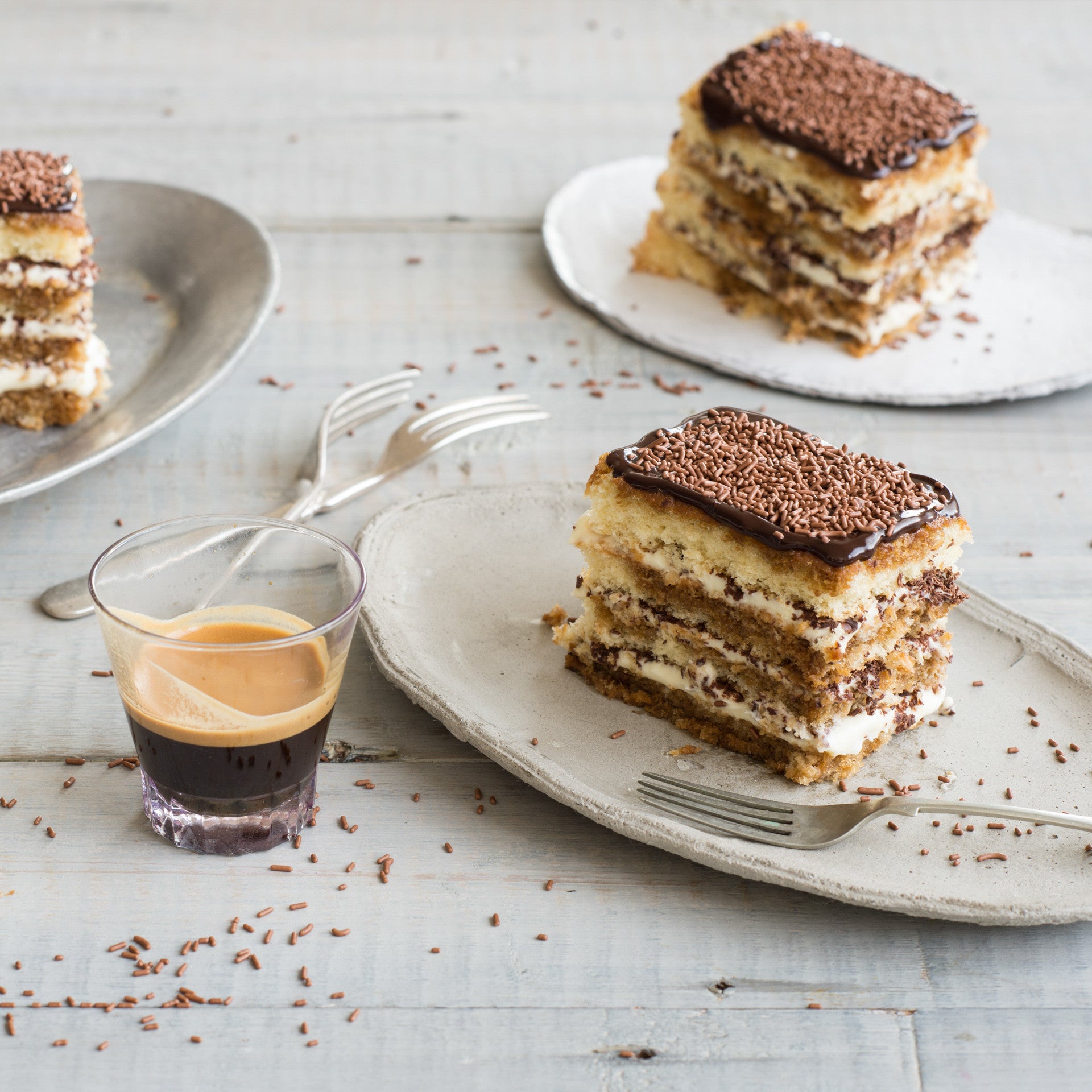
Prep 40min (+2hr 30min chilling and 20min cooling time)Bake 15minMakes 8 serves
This Italian classic is taken to a whole new level as elegant individual dessert cakes with a rich chocolate topping... Just serve with a fork!
Ingredients
185ml (¾ cup) strong freshly brewed coffee60ml (¼ cup) Marsala
75g good-quality dark chocolate (70% cocoa), grated
Chocolate dollar fives, to sprinkle (optional)
Sponge Layers
Melted butter, to grease4 eggs, at room temperature
165g (¾ cup) caster sugar
60ml (¼ cup) milk
20g butter
110g (¾ cup) self-raising flour, plus extra to dust
30g (¼ cup) cornflour
Mascarpone mixture
150ml thickened cream90g (⅔ cup) icing sugar, sifted
125g mascarpone
Chocolate ganache
250g good-quality dark chocolate (54% cocoa), chopped80ml (⅓ cup) pouring cream
Method
- To make the Sponge Layers, place the oven rack in the lower third of the oven and then preheat it to 180°C (160°C fan-forced). Brush two 30cm x 20cm shallow cake tin with a little melted butter to lightly grease and hen line the base and sides with one piece of baking paper, cutting into the corners to fit.
- Use an electric mixer with a whisk attachment on high speed to whisk the eggs and sugar in a large bowl until until the mixture is very thick and pale (this will take about 5 minutes). Lift the whisk out of the mixture and draw a figure eight, if the trail stays on the surface long enough for you to finish drawing then the mixture is ready. If not, continue to whisk for a further minutes and then test again.
- Heat the milk and butter in a small saucepan over medium heat just until the butter melts. Remove from the heat. Sift the flour and cornflour together over the egg mixture. Immediately pour the warm milk mixture down the side of the bowl and whisk again with the electric mixer briefly, until the flour mixture is just incorporated (be careful not to over mix).
- Divide the mixture evenly between the prepared tins, and use a spatula or the back of a spoon to spread evenly. Gently tap the tins on the bench top three times to settle the mixture. Bake in preheated oven for 12-14 minutes or until the cake is a pale golden colour, spring back when lightly touched in the centre and start pulling away from the sides of the tin. Remove from the oven and stand for 2 minutes before turning onto a wire rack to cool completely (this will take about 20 minutes).
- Line the base and sides of a 16cm x 26cm cake tin with two strips of non-stick baking paper allowing the paper to overhand the sides by about 10cm.
- To make the mascarpone mixture, use an electric mixer with a whisk attachment to whisk the cream and icing sugar on medium speed until soft peaks form. Add the mascarpone and whisk until firm peaks just form.
- Cut each of the sponge in half. Combine the coffee and Marsala. Place one sponge layer on the base of the prepared tin and sprinkle with a quarter of the coffee mixture. Spread with a third of the Mascarpone mixture (about ½ cup) and then sprinkle with a third of the grated chocolate. Continue to layer with the remaining sponge, coffee mixture, grated chocolate and mascarpone mixture, finishing with a sponge layer sprinkled with the remaining coffee and Marsala mixture. Cover with plastic wrap and place in the fridge for at least 2 hours or until firm enough to cut.
- Use the overhanging baking paper to remove the tiramisu from the tin and transfer to a cutting board. Use a sharp knife trim the edges and then cut into 8 portions about 4.5cm x 7cm each and place on a wire rack over a tray. Return to the fridge while making the Chocolate ganache
- To make the Chocolate ganache, combine the chocolate and cream in a heatproof bowl and place over a saucepan of barely simmering water (make sure the base of the bowl doesn’t touch the water). Stir occasionally until just melted and combined.
- Remove the cakes from the fridge and place on a wire rack. Pour a little of the Chocolate ganache over each cake, spreading it to cover the top. Sprinkle with the chocolate Dollar Fives if using and return to the fridge for 30 minutes or until the ganache is set before serving.
Baker's Tips
- These Tiramisu cakes will keep in an airtight container in the fridge for up to 3 days.
This recipe is from Anneka's SBS Food online column, Bakeproof: Little Cakes. CLICK HERE for more Bakeproof recipes.
Photography by Alan Benson.

Prep 50min (+30min cooling and 30min standing time)Bake 25minMakes about 12
I debated about what to call these — a combination of the much-loved Arnott’s iced VoVo biscuits and the iconic lamington. Such a visual treat. I hope you love these fun little cakes as much as I do.
Ingredients
130g (2 cups) shredded coconut
48 fresh raspberries, halved lengthways, to decorate
Cakes
melted butter, to grease
105g (¾ cups) self-raising flour
75g (½ cup) plain flour
165g (¾ cup) caster sugar
125g butter, at room temperature
80ml (⅓ cup) milk
2 eggs, at room temperature
1 teaspoon natural vanilla extract or essence
1½ tablespoons raspberry jam
Raspberry frosting
2 egg whites
75g (⅓ cup) caster sugar
2 tablespoon raspberry jam, warmed and sieved
rose pink food colouring
Method
- Preheat the oven to 180°C (160°C fan-forced). Brush a 12 x 80ml (⅓ cup) rectangular friand or mini-loaf pan with melted butter to grease.
- Place the flour, sugar, butter, milk, eggs and vanilla in a large mixing bowl. Use an electric mixer to beat on low speed until combined. Increase the speed to medium and beat for 3 minutes or until the mixture is well combined and very pale in colour. Divide half the mixture among the friand pans and spoon the surface of each with the back of a teaspoon. Spoon ½ teaspoon of jam into the centre of each and then spoon the remaining cake batter over the top to cover, dividing evenly, and smoothing the surfaces carefully with the back of the spoon.
- Bake for 20-25 minutes or until the cakes are golden and cooked when tested with a skewer. Cool for 5 minutes in the pan, then transfer to a rack to cool completely (this will take about 30 minutes).
- To make the raspberry frosting, choose a medium heatproof mixing bowl that sits snugly on top of a medium saucepan. Quarter-fill the saucepan with water and bring to the boil. Reduce the heat to lowest possible setting. Put the egg whites and sugar in the heatproof bowl and place over the simmering water. Use a spatula to stir until the sugar dissolves. (You can tell if the mixture is ready by rubbing a little between your fingers — if it still feels grainy then continue to stir for another minute or until it no longer feels grainy.) Transfer the mixture to the bowl of an electric mixer and use a whisk attachment to whisk on high speed for 3-5 minutes or until very thick and glossy. Whisk in the jam until evenly combined. Add 2-3 drops, or enough to reach desired colour, of the food colouring to the meringue mixture and whisk until evenly combined.
- When the cakes are cool, spread the coconut on a tray. Spread the raspberry frosting over the top and sides of a cake and then dip the sides in the coconut to coat. Place on a serving plate and place 4 raspberry halves down the centre on top to decorate. Repeat with the remaining cakes, frosting, coconut and fresh raspberries. Set aside for 30 minutes for the frosting to firm slightly before serving.
Baker's Tips
- These cakes, without the fresh raspberries, will keep in an airtight container at room temperature for up to 2 days.
This recipe is from Anneka's SBS Food online column, Bakeproof: Aussie Day Favourites.
CLICK HERE for more Bakeproof recipes.
Photography by Alan Benson.
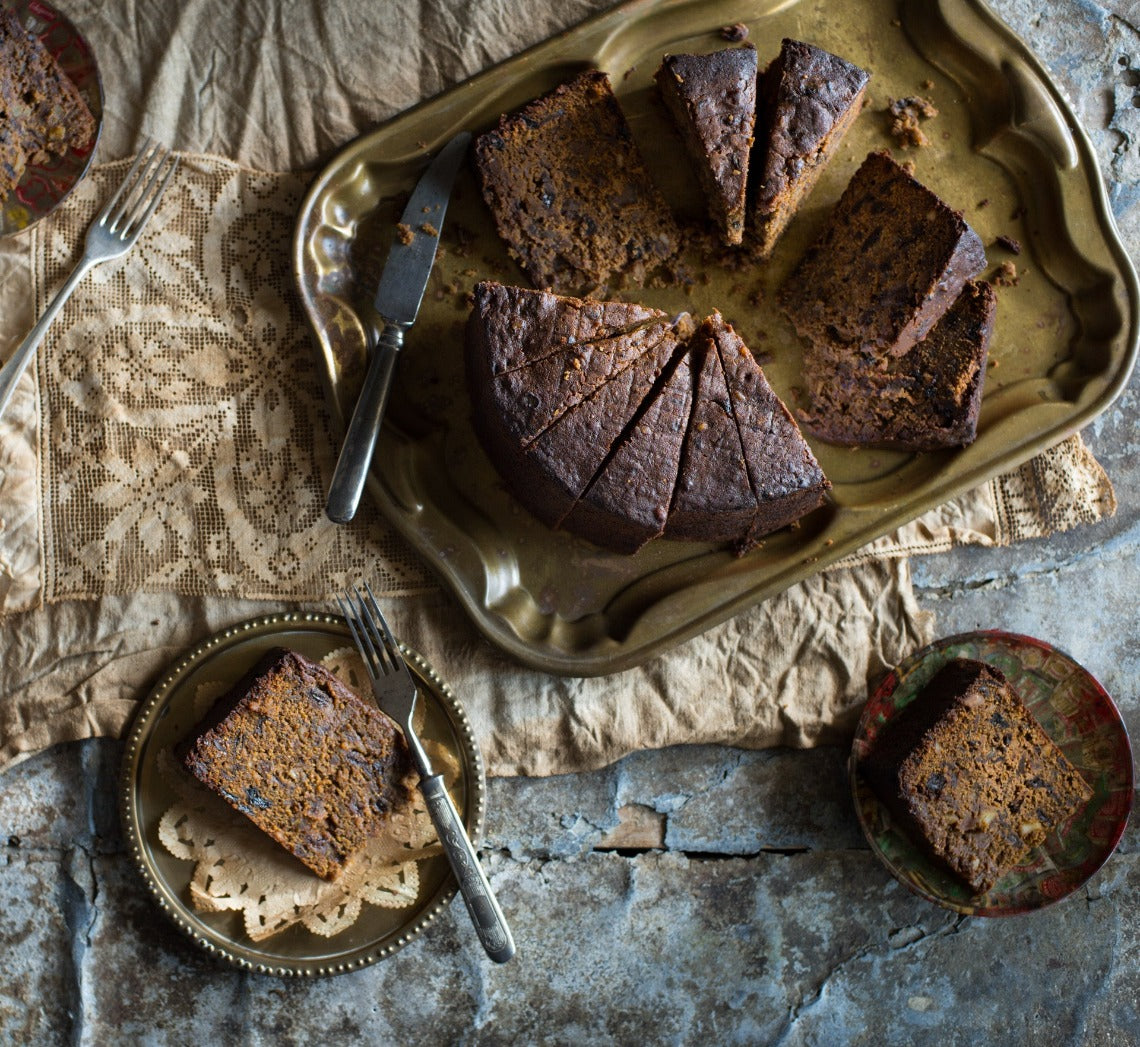
Prep 30min (+3days soaking and overnight cooling time)Bake 2hr 30minMakes 20 serves
This is Colombia’s version of a rich fruit cake. Dense with prunes, raisins and figs, generously spiked with both rum and port, and cleverly flavoured with aromatic spices, it is hard to stop at one piece. Traditionally dulce quemado (sweet burnt brown sugar), either homemade or bought, is used to sweeten this cake, but molasses makes a perfectly acceptable substitute as I've done in this recipe.
You will need to start this cake at least 6 days before baking.
Ingredients
200g (1 cup) pitted prunes
170g (1 cup) seedless raisins
80ml (⅓ cup) port, plus 80ml (⅓ cup) extra
60ml (¼ cup) dark rum, plus 60ml (¼ cup) extra
80g (½ cup) blanched almonds
50g (½ cup) pecans
melted butter, to grease
200g (1 cup) tenderised figs or drained figs in syrup (see Baker's Tips), finely chopped
250g butter, at room temperature
275g (1¼ cups) caster sugar
2 teaspoons vanilla essence
5 eggs, at room temperature
250g (1⅔ cups) plain flour
1 teaspoon baking powder
½ teaspoon ground cinnamon
¼ teaspoon ground nutmeg
¼ teaspoon ground cloves
¼ teaspoon salt
2 tablespoons molasses (see Baker's Tips)
Method
- Process the prunes and raisins in a food processor using the pulse button until chopped. Transfer to a bowl and stir in the port and rum. Cover and set aside for at least 3 days to soak (see Baker's Tips).
- Preheat oven to 170°C (150°C fan-forced). Grease a deep round 20 cm cake tin with melted butter and line the base and sides with non-stick baking paper.
- Process the almonds and pecans in a food processor until chopped. Add to the prune mixture with the figs and stir to combine evenly. Use an electric mixer to beat the butter, sugar and vanilla until pale and creamy, scraping down the sides of the bowl when necessary. Add the eggs one at a time, beating well after each addition.
- Sift together the flour, baking powder, spices and salt. Add to the butter mixture and beat on lowest possible speed until just combined. Add the molasses and beat on low until just combined. Use a wooden spoon to stir in the fruit and nut mixture until evenly combined.
- Spoon the mixture into the prepared tin, pressing well into the corners, and then smooth the surface with the back of a spoon. Cover the tin with a piece of foil and then bake in preheated oven for 2 hours and 25 minutes to 2 hours and 35 minutes or until cooked when tested with a skewer.
- Remove from the oven and stand in the tin for 10 minutes before turning onto a wire rack. Combine the extra port and rum and brush over the top of the cake. Wrap the warm cake in plastic wrap and then foil and set aside overnight to cool.
- Store for at least 3 days at room temperature before serving.
Baker's Tips
- The prunes and raisins require 3 days or more to soak, so you could start the soaking one weekend and cook the cake the next.
- Dulce quemado (sweet burnt brown sugar) is traditionally used in this cake and is considered more important than the alcohol or spices to add flavour. It not only adds a rich colour but also a sweet/bitter flavour to the cake. It can be home made or bought, although outside of Latin America it can be hard to track down. Molasses makes a good substitute.
- This cake will keep wrapped well in plastic wrap and sealed in an airtight container in a cool spot, but not in the fridge, for up to 3 months.
- To make the lattice pattern on the top of the cake as we have, turn the cake upside down on a cake rack after cooling and press down firmly. Turn the cake 90 degrees and press again.
This recipe is from Anneka's SBS Food online column, Bakeproof: Latin American Cakes.
CLICK HERE for more Bakeproof recipes.
Photography by Alan Benson.
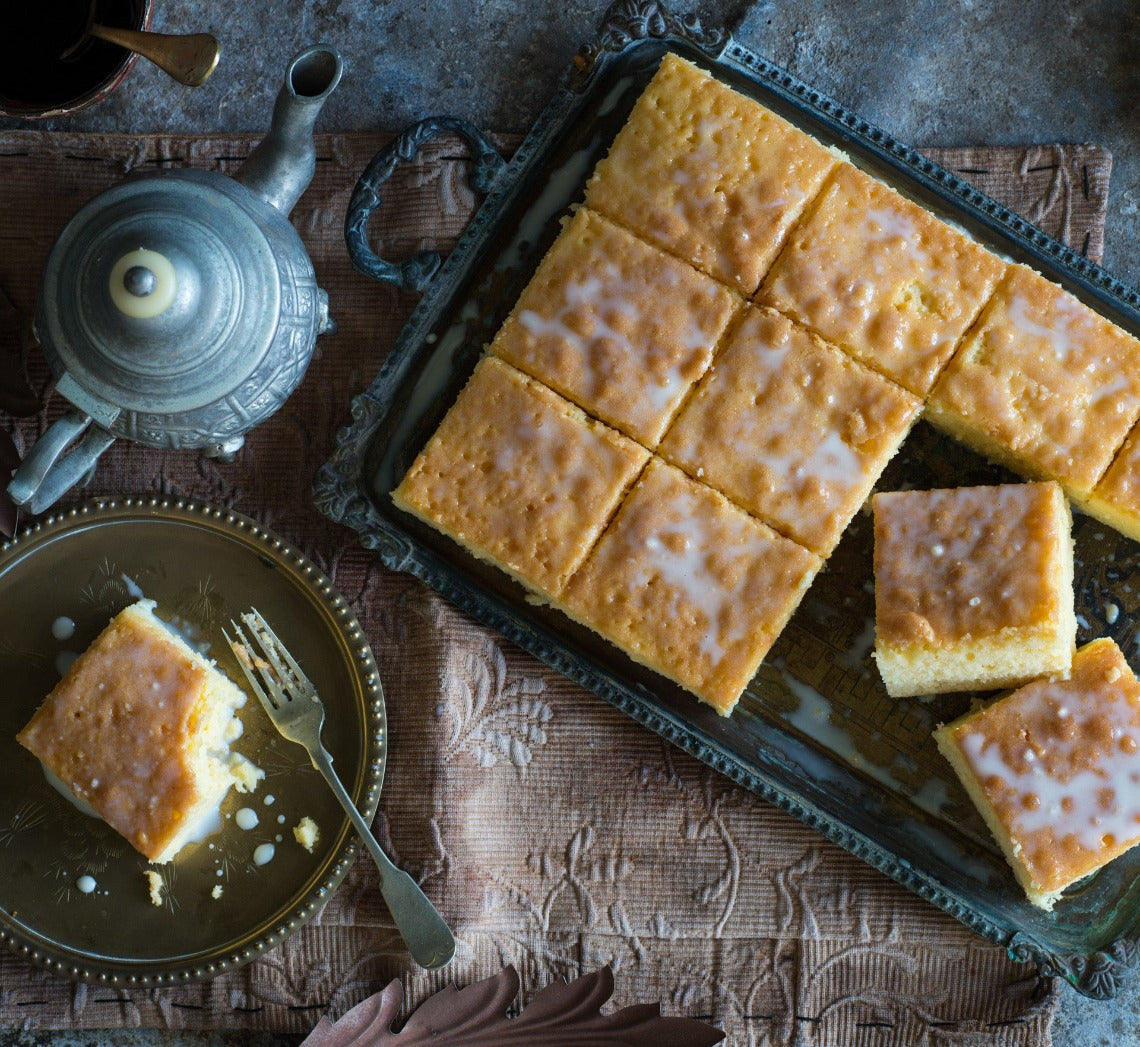
Prep 30min (+3hr chilling and 2hr cooling time)Bake 35minMakes 12 serves
Immensely well-loved in Latin America, a recipe for this wonderfully milky cake appeared on the label of Nestle’s sweetened condensed milk cans in the 1940s, possible explaining why its popularity has spread so widely in this part of the world.
Ingredients
Sponge Cake
5 eggs, at room temperature
220g (1 cup/7¾oz) caster sugar
125g (4½oz) butter, melted
150g (1 cup/5¼oz) plain flour
75g (½ cup/2¾oz) self-raising flour
1 teaspoon natural vanilla essence or extract
Milk Syrup
395g tin sweetened condensed milk
150ml evaporated milk
250ml (1 cup) full-cream milk
Method
- Preheat the oven to 180°C/350°F (160°C/315°F fan-forced). Grease a 20cm x 30cm (8in x 12in), base measurement, shallow cake tin or lamington pan and line the base and two longs sides with one piece of non-stick baking paper.
- Use an electric mixer with a whisk attachment to whisk the eggs on high speed until combined. Gradually add the sugar, about 55g (¼ cup/2oz) at a time, whisking well after each addition. Once all the sugar has been added, whisk on high for a further 4 minutes or until the mixture is very thick and a ribbon trail forms when the whisk is lifted. Reduce the mixer speed to low and gradually add the melted butter, whisking until just incorporated. Sift together the plain and self-raising flours. Add to the egg mixture in three separate batches, whisking on low speed between each addition until just combined and scraping the bottom of the bowl when necessary to make sure all the flour is incorporated.
- Pour batter into the prepared tin and gently tap it on the bench three times to remove any excess air bubbles. Bake in preheated oven for 30-35 minutes or until the cake is firm when touched in the centre and a skewer inserted in the centre comes out clean.
- Just before the sponge is ready, make the Milk Syrup by combining the sweetened condensed milk, evaporated milk and milk in and bowl and stirring with a balloon whisk until well combined. Transfer to a jug.
- Remove the sponge from the oven and stand in the tin for 3 minutes before inverting onto a tray with a lip. Use a skewer to prick holes all over the surface of the cake and all the way through. Pour the milk mixture evenly and slowly over the warm cake, allowing it to soak it up. Stand at room temperature until cool (this will take about 2 hours) and then refrigerate, uncovered, for 3 hours or overnight. Cut into pieces to serve (see Baker's Tips).
Baker's Tips
- For an extra rich cake you can top it with 375 ml (1½ cups) thickened cream that has been whisked to soft peaks with 2 tablespoons of sifted icing sugar and 1 teaspoon of natural vanilla essence or extract before serving.
- This cake will keep covered in the fridge for up to 3 days. Serve at room temperature.
This recipe is from Anneka's SBS Food online column, Bakeproof: Latin American Cakes.
CLICK HERE for more Bakeproof recipes.
Photography by Alan Benson.






